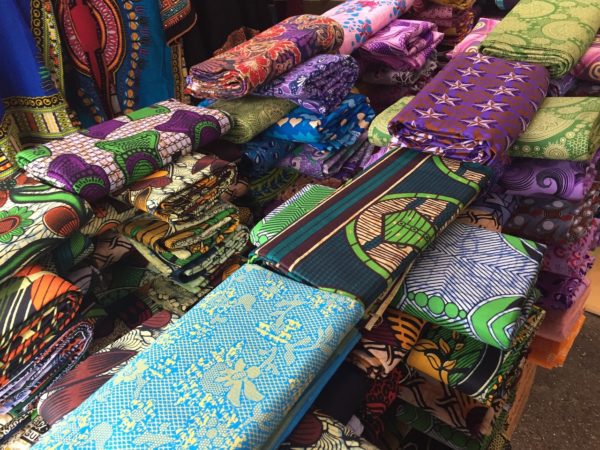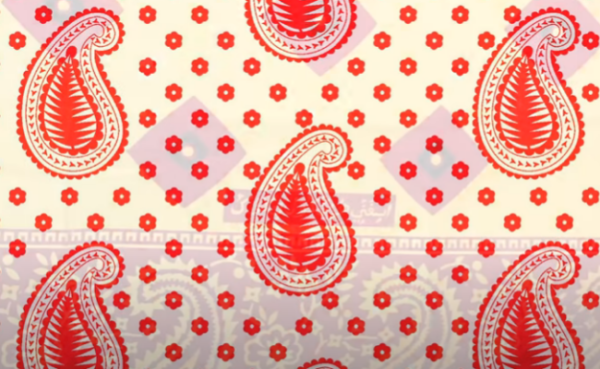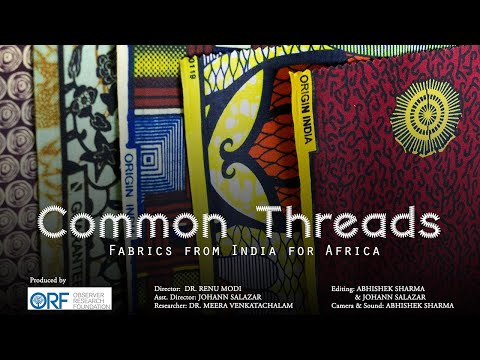|
Get AfricaFocus Bulletin by e-mail!
Format for print or mobile
India/Africa: Common Threads of Kanga and Vitenge
AfricaFocus Bulletin
September 14, 2020 (2020-09-14)
(Reposted from sources cited below)
Editor's Note
The new book Common Threads (along with an accompanying video, both
open access), explores the ties that bind India and Africa through
the material medium of cloth, from antiquity to the present. Cloth
made in India has been sold across African markets for millennia,
by Indian, African, and European traders. ... Most significantly,
it highlights the role of African consumers in defining the
evolution of these genres of fabric, and the centrality of people-to-people connections in sustaining the continued cosmopolitanism
of these transoceanic connectivities.
This AfricaFocus Bulletin features an interview with one of the
editors of this vividly illustrated book, brief excerpts from the
book, and a link to the 22-minute video which vividly portrays the
fabric and the people who make it, trade it, and wear it. For
anyone interested in the long history and present reality of South-
South cooperation across the Indian Ocean, this is an incredible
resource.
AfricaFocus normally focuses on current realities and crises. But
it is well worth making an occasional exception, even in terms of
understanding the present, because the world´s response to African
crises is still beset by cultural stereotypes and misunderstandings
deeply rooted in history. I highly recommend this well-researched
and well-presented project.
For previous AfricaFocus Bulletins on culture, visit
http://www.africafocus.org/cultexp.php. For previous AfricaFocus Bulletins on trade, visit http://www.africafocus.org/tradexp.php.
The book Common Threads is available as a PDF download at https://openaccess.leidenuniv.nl/handle/1887/120547. A print version is available for order at
http://www.ascwebshop.nl/Common-threads-:-fabrics-made-in-India-for-Africa
The video is available at https://www.youtube.com/watch?v=jplcCfOfi5A.
++++++++++++++++++++++end editor's note+++++++++++++++++
|
Common threads – the ties that bind India and Africa through fabric
Cliffordene Norton, Meera Venkatachalam
Voertaal Academisch
2020-08-19
https://voertaal.nu/common-threads-the-ties-that-bind-india-and-africa-through-fabric/
Common threads: Fabrics made-in-India for Africa
Edited by M Venkatachalam, R Modi and J Salazar
Published by African Studies Centre Leiden
Common Threads explores the ties that bind India and Africa through
the material medium of cloth, from antiquity to the present. Cloth
made in India has been sold across African markets for millennia,
by Indian, African, and European traders. The history of this trade
offers perspectives into the rich stories of bi-directorial
migrations of peoples, across the Indian Ocean, the exchange of
visual aesthetics, and the co-production of cultures in the two
geographies. Common Threads uses photographs to tell the story of
the creation of these textiles in India, which today is
concentrated in the small town of Jetpur in the Rajkot district of
Cujarat. It sheds light on the artists and the agencies in India
that are involved in the design, production, and logistics of this
enterprise. Most significantly, it highlights the role of African
consumers in defining the evolution of these genres of fabric, and
the centrality of people-to-people connections in sustaining the
continued cosmopolitanism of these transoceanic connectivities.
|

|

|
Photo credits for vitenge on left and kanga on right:
http://pixabay.com and http://youtube.com.
Cliffordene Norton interviews Meera Venkatachalam, co-editor of
Common threads: Fabrics made-in-India for Africa.
Q: Congratulations on the publication of your book, Common threads:
Fabrics made-in-India for Africa. What was the inspiration behind
this book?
A: This project began when we learned that African prints were
being made in factories around Mumbai for consumers all over
Africa, from Nairobi to Lomé. We were well aware that African
prints were manufactured in the Netherlands and, more recently, in
China, but we did not know that the iconic wax print – among other
types of cloth – was being designed and manufactured in India. So,
we attempted to tell this story, contextualising India’s current
role in producing cloth for Africa against the backdrop of its
historical status as a major global cloth producer.
Q: Why focus on this history of the textile trade?
A: It is well known that India was a major producer of cloth for
millennia. But it is generally believed in India that the colonial
era disrupted Indian cloth production – that raw materials were
exported from India to Europe, and that British-manufactured goods
were received into the Indian market. However, a glimpse into the
textile trade between India and Africa in the colonial era reveals
that the textile industry – especially in western India and Mumbai
(then Bombay) – grew substantially in the colonial era by adapting
to the demand for cloth in Africa. This phenomenon fuelled colonial
Bombay’s industrialisation, a little-known historical fact.
Q: When did the textile trade between India and Africa start?
A: This trade is over 2 000 years old!
Q: The spice route between India and Africa is well known. Has your
research revealed any similarities or differences between these two
trade routes/products?
A: We have attempted to historicise our work and to view current
textile production in India for Africa against broader temporal
trajectories. There are both continuities and discontinuities.
The current trade to East Africa may be viewed as a continuity of
older precolonial and colonial routes and processes, which
facilitated the circulation of peoples, goods and capital between
India and East Africa. For instance, Indian families with strong
links to the Indian diaspora in East Africa are engaged in the
cloth trade today, relying on the know-how of Indians settled
there, for conducting market research and negotiating access to
markets. But today, we also find Indian traders operating in
markets in West Africa – this is a new phenomenon, as, unlike in
East Africa, Indian traders have never been present in West Africa
in large numbers until now.
Q: Common threads uses photographs to tell the story of the
creation of these textiles in India. Why did you use this research
method?
A: The patterns and designs represented in this cloth – from the
East African kanga to what is known as kitenge – tell stories that
are deeply embedded in the sociocultural matrixes of the people who
wear them in Africa. We wanted to show as many of them as possible
in our book.
Q: Take us through the process of compiling and editing the book.
A: It has taken us three and a half years to put this together. We
had to sift through large quantities of field notes, photographs
and video clips generated out of our fieldwork. We also read
previously published literature on the subject. Eventually, we
began to see it fall into place, and our focus came to rest on
Indian designers and merchants in the cloth trade, on the genres of
African designs and on the process of production in India.
Q: What did you edit out of this book?
A: As we began writing, we realised that we were telling the story
not just of the cloth trade between India and Africa, but of other
movements which were intertwined with the cloth trade – such as the
slave trade from Africa to India, and free and unfree migrations of
people from the Indian subcontinent to Africa. We tried to
incorporate as many of these related phenomena as possible, while
staying focused on cloth. Therefore, some of these themes are
introduced very briefly, and many details which we would have liked
to include are left out.
We also have a number of pictures of beautifully designed African wax prints and kangas which did not make it into the book!
Q: How would you bridge the gap from your research to research users?
A: We have tried to use as many visual aids as possible to achieve this, from the use of photographs to making a film.
Q: How do you see this book impacting the field?
A: We hope to highlight the current Indian agency in producing
cloth for Africa, which is not well known. We also hope to
highlight other themes in the study of India-Africa relations and
African studies, which are discussed only in passing in this book,
but are in need of more research. For instance, thousands of
itinerant African traders and entrepreneurs come to India several
times a year to buy consumer goods for sale in their countries of
origin. Also, India is home to a small but growing African diaspora
now – and very little is known about this.
Q: How do you feel about converting your research into the documentary Common threads – Fabrics from India for Africa?
Our film, also called Common threads: Fabrics made-in-India for Africa, was premiered at the Zanzibar International Film Festival in 2018 (ZIFF 2018) and was shortlisted in the documentaries section. It can be viewed at: https://www.youtube.com/watch?v=jplcCfOfi5A
We made the film in order to reach a broader non-academic audience,
and we hope this has been the case! We thank our publishers, ASCL,
for working with us to produce the book, and we are pleased that it
is open access.
******************************************************
Brief excerpts from Common Threads

The history of trade between India and Africa has been inextricably
linked through the material medium of textiles. ‘Common Threads:
Fabrics made in-India for Africa’, contextualises India’s role in
the production of textiles and the lesser-known trade in
beautifully printed cloth for African markets. This trade that has
existed since antiquity and continues to the present time has
created longstanding people-to-people connections across the Indian
Ocean. It showcases the way in which the production, trading, and
exchange of textiles manufactured in India has been governed by
discerning consumer preferences on the African continent for
centuries.
This project was conceptualised at the Centre for African Studies,
University of Mumbai, in early 2016. We learnt that there were
factories in western India – in Tarapur, on the outskirts of
Mumbai, and in the town of Jetpur, in Gujarat – that produce bright
and vibrant kanga and vitenge, ‘African prints’ for consumers
across Africa. This project entailed fieldwork mainly in Tarapur
(Maharashtra, India) and Jetpur (Gujarat, India), Nairobi and
Mombasa (Kenya), and Dar es Salaam and Zanzibar (Tanzania). The
project took about three years to complete. It culminated in this
photo-essay book and a documentary film.
There exists a commendable body of scholarly work on the subject,
published by established historians of textiles and the Indian
Ocean world, and by art historians. We read their work with great
interest, built upon the existing knowledge, and added an ‘India
focus’, to fill in the gap. We realised that rich oral narratives
of the ‘old diaspora’, mainly Gujaratis who had immigrated to East
Africa in the early nineteenth century and thereafter were not
documented although they had been a part of the designing, trading,
and consumption of these African prints – kanga and kitenge – since
the inception of these genres of cloth.
At ‘Mali Ya Abdulla’ (est.1887, Biashara Street, Mombasa), we were
privy to some of the most astounding printed fabrics, from the
colonial period or thereabouts. We have captured these on camera
and have showcased them in this volume. We also came across several
other noteworthy visual representations on cloth, which have deep
social, political, and cultural meanings to people in Africa. Thus,
each image printed on the fabric in this volume is a repository of
multiple aspects of life on the Swahili coast and beyond. The
textiles are also testimony to the transoceanic co-production of
cultures and cosmopolitanism of the Indian Ocean world. One example
is the little studied exchange of aesthetics of personal adornment,
family memories, and storytelling as described by writer Sultan
Somjee in his novel Home Between Crossings.
...
A kanga is a cloth with a thick border on all four sides, measuring
66 x 44 inches, worn in pairs around the waist and chest. Swahili
or English proverbs are often imprinted upon the kangas. In Jetpur,
kitenge refers to any nonkanga type of continuous fabric: 6 or 12
yards, printed in a variety of styles ranging from ‘wax prints’ to
batiks with a thin border. Vitenge are worn in a number of ways in
different cultural zones. Rural West African women wear two six-
yard pieces, one secured around the waist and another below the
shoulders, tied with a cord. The pieces do not necessarily
correspond to each other. Urban African women sew them into one or
two-piece dresses of different patterns, sometimes worn with
matching headgear. This two-piece dress, styled in the fashion of a
Victorian woman’s attire, is known as the kaba in Ghana, and a buba
and iro in the Yoruba-speaking belt of Nigeria. Varieties of
vitenge are also in demand in East African markets. The development
of East and West Africa as discrete cloth zones is a residual
feature of a longer history of India’s positioning within global
dynamics of trade.
...
Over the centuries, the Indian cloth trade has developed through
two very different trajectories across East and West Africa.
Geographically, East Africa is closer and therefore more accessible
from India. The Periplus of the Erythraean Sea (hereinafter ‘The
Periplus’), a Greco-Roman manual on trade and navigation from the
first century AD, describes an active trade between ports such as
Barygaza (Baruch) on the western coast of India and the East
African port cities such as Adulis of the Aksum Empire
(contemporary Eritrea), Malao in Berbera (contemporary Somalia),
and Rhapta in Azania (around present-day Dar es Salaam) (Schoff,
1912, pp. 22-3, 25-6; 28, 39). Facilitated by the monsoon winds,
the dhows (wooden 29boats with sails), moved peoples, goods, and
ideas between the coast of East Africa, and the shorelines of
western India and Arabia (Sherriff, 1987, p. 2).
This trade continued through the medieval period and received an
immense stimulus through the European presence in the Indian Ocean
during the colonial era. People, cultures, and ideologies of both
the terrains – India and Africa – were in frequent contact with
each other for centuries. Africans, generically known as Habshis (a
corruption of Habesha, the name used for Abyssinia or Ethiopia)
were frequently encountered in medieval and early- modern India.
They came as traders, soldiers, and slaves. Africans played a
crucial role in the history of Delhi, the Sultanates of Gujarat,
the pre-Maratha Deccan and the Bahmani kingdom (Alpers 2017, pp.
62-3).
Trade between India and West Africa followed a different
trajectory. Historically, Indian traders had little knowledge,
contact, or control over West African markets. This region was
located further away – double the distance as compared to East
Africa, which was only about 4000 kms away from Mumbai. In the pre-
colonial era, India simply did not have the same immediacy in West
African imagination as it did in East Africa, remaining a distant
construct, created through the re-envisioning of several cultural
interlocutors. Indian cloth entered West African markets as re-
exports as Indian cloth enjoyed a global reputation on account of
its high quality, variety, and colours. It was sold by
intermediaries – Arabs, Ottomans, other Africans, and Europeans –
through land routes from the Middle East, southern Europe, and the
Sahara. During the colonial era, Indian cotton continued to enter
West African markets through oceanic routes opened up by the
European colonial powers (Johnson, 1974; Lemire & Riello, 2006;
Riello, 2010).
...
People-to-people narratives in Indo-African relations
Popular accounts of the relations between the people of India and
countries in Africa are often marked by incidents of mutual
hostility. Africans of Indian origin have faced antagonism in their
adopted homes, culminating in the 1972 expulsion of Asians under
Idi Amin, whose reasons for expulsion were among other things,
driven by his ‘Africanisation’ agenda (Amor, 2003). Similarly,
Africans in India have been at the receiving end of sporadic but
consistent racist violence (Modi & D’Silva, 2016). In recent years,
even the symbolism of Gandhi, once seen as a bridge between India
and Africa because his struggle against imperialism was shaped by
his experiences in both regions, has become steeped in controversy
amid accusations of him being racist towards Black Africans.
However, these sensational incidents of antagonism, which have come
to occupy primacy in the narrative of Indo-African relations,
obfuscate a long, quotidian and an extraordinary history of
people-to-people connections that, on closer investigation, paints
a picture of co-existence and harmony. Many Indians in Africa are
thoroughly interwoven into the fabric of their adopted homelands
(Oonk, 2013). They prefer to be identified as Africans first and
foremost, and recognise themselves as ‘People of Indian Origin’
only secondarily (McCann, 2011). Similarly, many Africans are
integrated into the socio-cultural matrixes of their Indian host
communities, through community organisations and religious
networks, and play significant and valued roles in promoting inter-
cultural understanding. This complex dynamic of Indo-African
people-to-people relations in both geographies remains
understudied. This book is an evidence-based endeavor to shed light
on these long-standing associations and demonstrate that they
persevere to this day.
AfricaFocus Bulletin is an independent electronic publication
providing reposted commentary and analysis on African issues, with
a particular focus on U.S. and international policies. AfricaFocus
Bulletin is edited by William Minter. For an archive of previous Bulletins,
see http://www.africafocus.org,
Current links to books on AfricaFocus go to the non-profit bookshop.org, which supports independent bookshores and also provides commissions to affiliates such as AfricaFocus.
AfricaFocus Bulletin can be reached at africafocus@igc.org. Please
write to this address to suggest material for inclusion. For more
information about reposted material, please contact directly the
original source mentioned. To subscribe to receive future bulletins by email,
click here.
|
